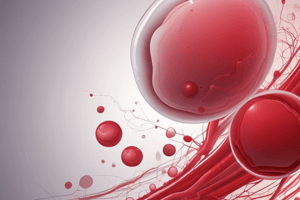Podcast
Questions and Answers
Which type of anemia is specifically caused by the failure of the bone marrow to produce blood cells?
Which type of anemia is specifically caused by the failure of the bone marrow to produce blood cells?
- Vitamin-deficiency anemia
- Hemolytic anemia
- Iron-deficiency anemia
- Aplastic anemia (correct)
Which group of people is NOT typically considered at higher risk for anemia?
Which group of people is NOT typically considered at higher risk for anemia?
- People with chronic diseases
- Teenage boys who eat a balanced diet (correct)
- Women of childbearing age
- Infants and young children
What is a common symptom of anemia that involves feeling faint or unsteady?
What is a common symptom of anemia that involves feeling faint or unsteady?
- Pale skin
- Poor concentration
- Cold hands and feet
- Dizziness or lightheadedness (correct)
Which diagnostic test measures the levels of hemoglobin and red blood cells?
Which diagnostic test measures the levels of hemoglobin and red blood cells?
Which symptom is NOT typically associated with anemia?
Which symptom is NOT typically associated with anemia?
Which type of anemia is due to chronic inflammation or infection?
Which type of anemia is due to chronic inflammation or infection?
Which of the following treatments is specifically used for severe aplastic anemia?
Which of the following treatments is specifically used for severe aplastic anemia?
What is a common cause of anemia that involves significant nutrient loss through surgery or injury?
What is a common cause of anemia that involves significant nutrient loss through surgery or injury?
Flashcards are hidden until you start studying
Study Notes
Definition and Types
- Anemia is a medical condition characterized by a decrease in the number of red blood cells or the amount of hemoglobin in the blood.
- There are several types of anemia, including:
- Iron-deficiency anemia: caused by a lack of iron in the diet
- Vitamin-deficiency anemia: caused by a lack of vitamin B12 or folate
- Anemia of chronic disease: caused by chronic inflammation or infection
- Aplastic anemia: caused by the failure of the bone marrow to produce blood cells
- Hemolytic anemia: caused by the destruction of red blood cells
Causes and Risk Factors
- Causes:
- Blood loss (e.g. from surgery or injury)
- Chronic disease (e.g. kidney disease, cancer)
- Poor diet or malnutrition
- Inherited disorders (e.g. sickle cell anemia)
- Chronic inflammation or infection
- Risk factors:
- Women of childbearing age
- Pregnant women
- Infants and young children
- People with chronic diseases
- Vegetarians and vegans (due to limited iron intake)
Symptoms
- Fatigue and weakness
- Shortness of breath
- Dizziness or lightheadedness
- Pale skin
- Headaches
- Cold hands and feet
- Poor concentration
Diagnosis
- Complete Blood Count (CBC) to measure hemoglobin and red blood cell count
- Blood tests to measure iron, vitamin B12, and folate levels
- Physical examination to check for signs of anemia (e.g. pale skin, jaundice)
Treatment
- Iron supplements or dietary changes to increase iron intake
- Vitamin supplements or injections to treat vitamin deficiencies
- Blood transfusions in severe cases
- Medications to treat underlying conditions (e.g. chronic disease, inflammation)
- Bone marrow transplantation in severe cases of aplastic anemia
Definition and Types of Anemia
- Anemia is a medical condition characterized by a decrease in red blood cells or hemoglobin in the blood.
- There are several types of anemia, including iron-deficiency, vitamin-deficiency, anemia of chronic disease, aplastic anemia, and hemolytic anemia.
Causes of Anemia
- Blood loss, e.g. from surgery or injury, can cause anemia.
- Chronic diseases, e.g. kidney disease, cancer, can cause anemia.
- Poor diet or malnutrition can lead to anemia.
- Inherited disorders, e.g. sickle cell anemia, can cause anemia.
- Chronic inflammation or infection can cause anemia.
Risk Factors for Anemia
- Women of childbearing age are at risk of anemia.
- Pregnant women are at risk of anemia.
- Infants and young children are at risk of anemia.
- People with chronic diseases are at risk of anemia.
- Vegetarians and vegans are at risk of anemia due to limited iron intake.
Symptoms of Anemia
- Fatigue and weakness are common symptoms of anemia.
- Shortness of breath is a symptom of anemia.
- Dizziness or lightheadedness can occur in anemia.
- Pale skin is a symptom of anemia.
- Headaches can occur in anemia.
- Cold hands and feet are a symptom of anemia.
- Poor concentration is a symptom of anemia.
Diagnosis of Anemia
- Complete Blood Count (CBC) is used to diagnose anemia.
- Blood tests measure iron, vitamin B12, and folate levels.
- Physical examination checks for signs of anemia, e.g. pale skin, jaundice.
Treatment of Anemia
- Iron supplements or dietary changes can increase iron intake.
- Vitamin supplements or injections can treat vitamin deficiencies.
- Blood transfusions are used in severe cases of anemia.
- Medications can treat underlying conditions, e.g. chronic disease, inflammation.
- Bone marrow transplantation is used in severe cases of aplastic anemia.
Studying That Suits You
Use AI to generate personalized quizzes and flashcards to suit your learning preferences.




